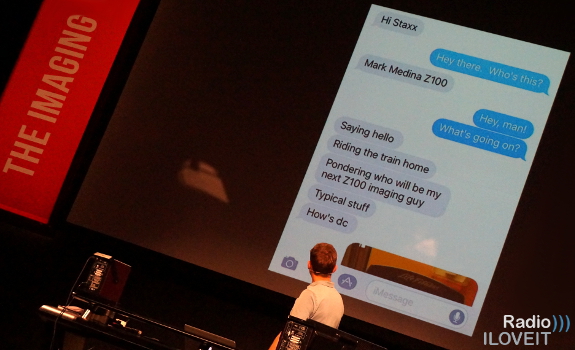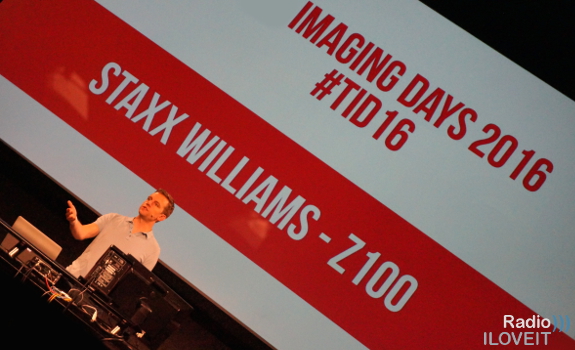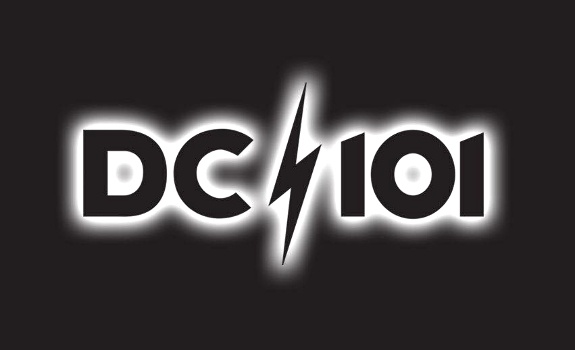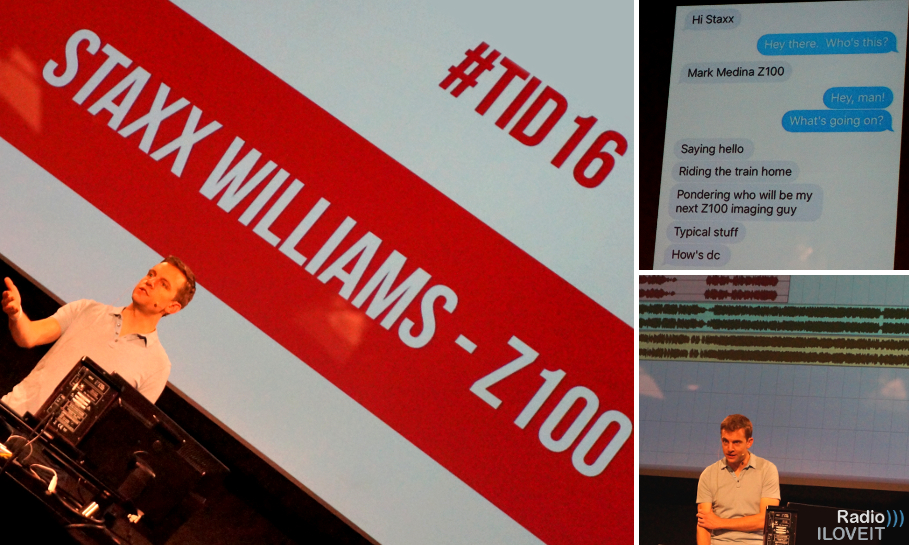A sound is worth a thousand words. That’s the philosophy of Z100’s Creative Services Director, Staxx Williams, when drawing a picture for the audience.
Following Dave Foxx’ move to Texas, Brent (‘Staxx’) Williams has taken over the reigns in New York, imaging iHeartMedia’s flagship Z100, as well as WKTU. How did he get the job that many producers are dreaming of, and what’s his view on station sound? He shared it in a presentation at The Imaging Days 2016, about applying your fantasy (“What if we did a scene with a stripper crying?”), and keeping it clean (“Our senses are overloaded all the time”).
“Keeping a positive attitude and trying to have fun has been working for me”

Before coming to New York, Staxx Williams worked at five other stations in three different markets (logos: Mel Wheeler, Inc., iHeartMedia)
Develop your communication skills
“I love my replacement”, Dave Foxx said about Williams on the previous day. “His heart is in the right place, his head is in the right place, he’s got style, he’s got grace; he has everything that I always wished I had — and he spells his name like I do, with two x’es, which is cool!” Staxx opened his talk with a shout-out to Foxx. “Dave has created a legendary brand that has defined a role for all of us for so many years. To step in that role is really very surreal.” He launched his career during college as “crazy stunt guy” for Mel Wheeler’s Roanoke, Virginia Top 40 station, K92, where he “fell in love” with radio and imaging. After four years, he went to iHeartMedia’s Baltimore, Maryland based Jack FM and Top 40 outlets 102.7 JACK-FM and Z104.3. Producing many promos and ads taught him to “craft your message through emotion”. Next, he went to iHeart’s DC cluster, imaging Classic Rock BIG 100.3, and the legendary rocker we know from the Howard Stern movie Private Parts, Alternative DC-101. Then, one day, he got a surprising text message.
Maintain your positive vibe
It was from Z100’s program director Mark Medina, looking for a new imaging guy for both New York’s #1 Hit Music Station and its Rhythmic Hot AC-ish sister WKTU. Staxx sent demos, and did interviews. Sometimes there was a period of silence in between. Then, after two months, he started receiving direct emails from Dave Foxx and Kelly Doherty (VP/Imaging for iHeart’s National Programming Platforms, a.k.a. ‘KellyKellyKelly’, heard as VO on countless iHeart stations). “I knew I had a pretty good shot at that point.” Looking back at his career so far, he has made himself stand out through a cooperative mindset, especially when working with demanding people, helping them out whenever they needed a favour that could be fulfilled. “I learned that I was always interviewing for the next gig.” The habit of always being “on your game” paid off, even if he couldn’t produce “solid gold” every time (as there’s only so much time in a day). He indicates that being “a guy or a girl that people like working with” might be just as important.
Grow your professional network
“Those little miniature interviews with people you meet throughout the years, and that you can impress, make a huge difference between a foot in the door and someone holding that door wide open when it knocks.” Williams met many people who are now working in New York City radio, years before they got there. “I knew that one day, it would probably lead to a good opportunity.” But standing in Dave Foxx’ shoes took him some time to get used to: “He’s a living legend. He’s still on the station; part of an iconic brand.” Suddenly being responsible for Z100’s imaging production, combined with personal life changes like moving to another city, felt both exciting and daunting. “Learning to work through that, knowing it’s a natural part of the process, was a valuable lesson for me. Just learn to relax, try to be ‘you’, and do great work. If you take big steps, it’s going to be scary, but keeping a positive attitude and trying to have fun all the time has been working for me.”
“Z100 is a powerhouse”

Williams values the heritage brand of New York’s #1 Hit Music Station (image: Thomas Giger)
Tell your story auditively
While he finds it impressive what other imaging producers are doing with sound editing and plugin settings, especially since he’s currently learning Pro Tools after using other software at previous stations, Staxx Williams confesses to be less technical and more visionary. “I’m better at being creative; trying to find different ways to approach things. When I write stuff, I don’t think of the words I’m gonna’ say. I try to see it, and think of what I might feel, or hear, or touch, or taste. It helps me craft sonic scenery.” What also makes him different from most producers, is the use of mostly real-life sounds instead of electronic effects. “It helps me draw a picture without using a lot of words.” An example is a promo for DC101, inspired by the video game Fallout 4, which is popular among the station’s target audience. “They have this awesome sonic branding”, he says, humming the three-note sonic logo from the game theme. “I asked the game production company if they could give us their work parts, and loan us their VO guy to read some of our stuff.”
Once the sweepers aired, DC101 received about “45,000 Twitter hits” from people asking about the game.
Find your personal flow
His advice is to keep both your audience and your personality in mind when developing a promotion. Referring to Dave Foxx’ presentation about Z100’s model listener, he says: “I’m not a 22-year-old female; I’m not Mika. That’s why I’m asking other people [from that age and gender] what goes on in their life.” In addition to staying in touch with the target audience, he will use something that he personally likes (such as the Fallout 4 game) or something that he’s good at (such as creative writing based on imagination) to get started. From there, everything else usually falls into place. Developing a workflow that works well for you is important, especially when you have many projects going on. While Z100 is his main priority, he’s also producing for KTU, and for various Rock stations. “They’re all very, very different. For some guys, that may be a side point, but I’m super-ADD in my mind, so it’s kind of bouncing around.”
Respect your heritage brand
While he likes to grow and evolve, Williams sees value in brand legacy. “Z100 is a powerhouse. Things have been done right for so long. I think of it like the Google logo. On some days, it’s a little different, based on what’s happening in the world. It’s not always super obvious as to what that is. That’s okay, because it’s still Google. I see Z100 in the same way.” So rather than making dramatic changes, he will add and remove small things, sometimes temporary. He plays some sweepers where he combined Dave Foxx’ and Kelly Doherty’s voiceovers with Star Wars soundscapes, which were on air when the 2016 movie came out. “Star Wars isn’t super girl-friendly, but it’s still fun, and everyone knows what it is.”
“I do a lot of the impersonations myself. I just go on YouTube, listening until I think I’ve got it right.” The concept of temporarily adding topical soundbites is also used on St. Patrick’s Day:
He says that he’s trying to divide the funny lines equally between Dave and Kelly, also because Dave is mostly an authority voice on the station.
“Maybe we should be cleaner and less dense”

Staxx Williams feels like life in New York is already busy and noisy enough (image: Thomas Giger)
Share your production collectively
He recalls when Pokémon GO became a worldwide phenomenon, virtually overnight: “I wanted to get it on the air asap, and reached out to as many friends as I could. Darrin Marshall, who works at HOT 99.5 in Washington, DC — a long-term mentor of mine, a good dude, and an amazing writer — sent me this line, and it came out so well.”
Staxx Williams is now happy to have and use a network of other creatives (working for the same company) to share production work among each other. “There was a time where I did not like using anybody else’s [stuff], ever. Every buzz and zap had to be mine; it was ‘my’ station.” Until at some point, workflow intervened. That’s when he realised: it’s much better to combine your efforts, like using someone else’s material and making it your own. There’s also another benefit: “Seeing how other people think, is changing how I think: I feel like I have to know a lot less than I thought I did, but it has made me smarter at the same time.” He now constantly uploads his production work for (iHeartMedia) colleagues.
Make your imaging PPM-friendly
The benefit of producing sweepers with an open ending, like those for Pokémon GO, is that they easily go over song intros (unless they are full instrumented or heavily compressed). “You can do your topicality without worrying about PPM, which really tightens up our windows where we can do content. I try to produce a lot with light sound effects, so it can sit over the music.” In answer to a question from the audience, he feels like PPM can be a frustrating thing, but it also led to good insights. “There’s a lot more tune-out than we thought: when a jock talks; when a sweeper starts; when a promo airs. People just want to hear the music. They also want content — but they want it really quick, and it’s got to be quality every time. His revelation that “half the [stuff]” he produces “doesn’t make it on the air, because we’re not quite sure that it’s gonna’ press the bill” indicates that programmers are cautious about what (imaging) they put in & around the music flow these days. Staxx says that if he doubts if something is appropriate or not, he’ll check it with Mark Medina first. Otherwise he just puts it on the air right away.
Compensate your market’s environment
Until the arrival of PPM, he used to produce longer promos with lots of beds and funny or crazy things. “We learned very quickly: people don’t dislike that, but to them, it’s a ‘commercial’. It’s not music; it’s not talk; it’s just noise. It’s us trying to sell stuff. You’ve got to compress your creativity through a smaller window.” Speaking of noise, Williams has a refreshing view on Z100’s possible future on-air sound, based on the fact that The Big Apple is a hectic place, with a lot to see, hear, touch, smell and taste: “Our senses are overloaded all the time. I try to consider that when doing stuff on the station. Maybe we should be cleaner and less dense, because everything else is cramming through for your attention.” When it comes to imaging, he believes in storytelling concepts that are meaningful (such as funny or relatable).
“I wanted to make it my show”

Here, Williams learned a valuable lesson about team spirit and brand legacy (image: Thomas Giger)
Trigger your listener’s response
Speaking of concepts that resonate with (or in any case move) the audience emotionally: During his session, Staxx Williams played two different productions for Father’s Day, showing how your copywriting & production can address one topic from very different angles. First, a witty, but entertaining Father Day’s spot for Z100’s young female audience:
How the same topic can take a convey a completely different emotion is proven by the following promo for male-oriented Alternative DC101. “This is a great example about thinking in scenery”, Staxx says. “My boss and I sat down, and I was like: what if we did a scene with a stripper crying? It was the most sad thing I could think of: a poor stripper, sitting in some brick wall covered room, crying through her make-up, who’s got to go on stage, and hates her life.” A female colleague acted the crying part, and he filtered out most high frequencies to mimic a small room’s acoustics:
Even though it feels uncomfortable — this is one powerful spot!
Practice your editing routine
Because he’s still getting acquainted with Pro Tools, he doesn’t use plugins to generate effects, but will instead create effects manually in the multitrack editor. An example is this promo for Z100’s annual Jingle Ball, containing not much more than voiceover and artist & crowd sounds (from the previous edition), and two music tracks:
The attention-grabbing stutter effect at the beginning was created by copy/pasting a very small voice segment several times, with a bit of empty space in between these repeated parts, combined with (what sounds like) backwards echo:
He’s using a minimum of impacts and swooshes, and prefers to create vocal FX like the above instead. “I try to not use too many sound effects, because it gets cleaner that way.”
Set your ego aside
And then, there was a surprise question from the audience!
Being very open, Williams admits that he made a serious mistake at DC101. “I really screwed that station up, because I wanted to do everything; I wanted to make it my show.” Having been a jock before, he was used to a certain amount of attention, which he didn’t get in DC, where he was producing imaging full time. Looking for some ompensation, he took off the main station VO a lot. “I replaced him with myself, trying to be him. It was a huge mistake.” Eventually, he realised that he would accomplish way more by having a team spirit, and by keeping a focus on common goals. As soon as he reached that conclusion, he reinstalled DC101’s imaging VO. “That station still uses that voice, and it sounds amazing. Z100 still uses Dave Foxx, and it sounds amazing.”
Header image: Thomas Giger






Add Your Comment